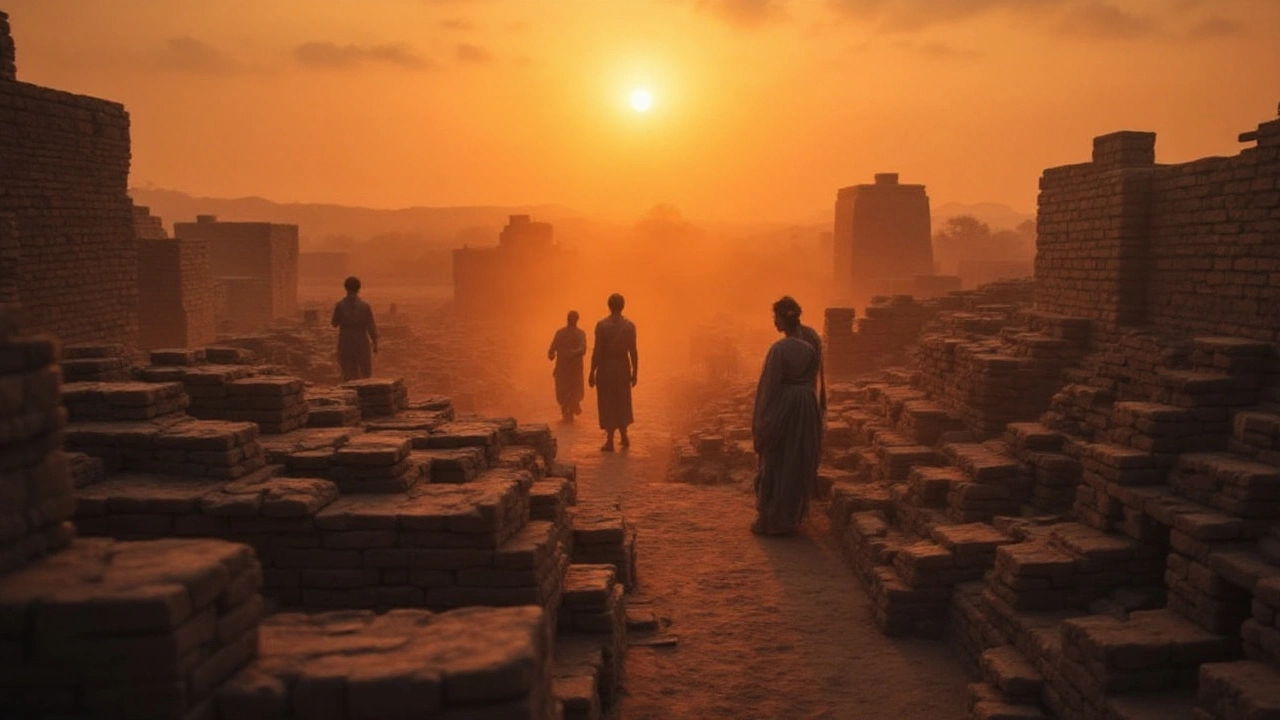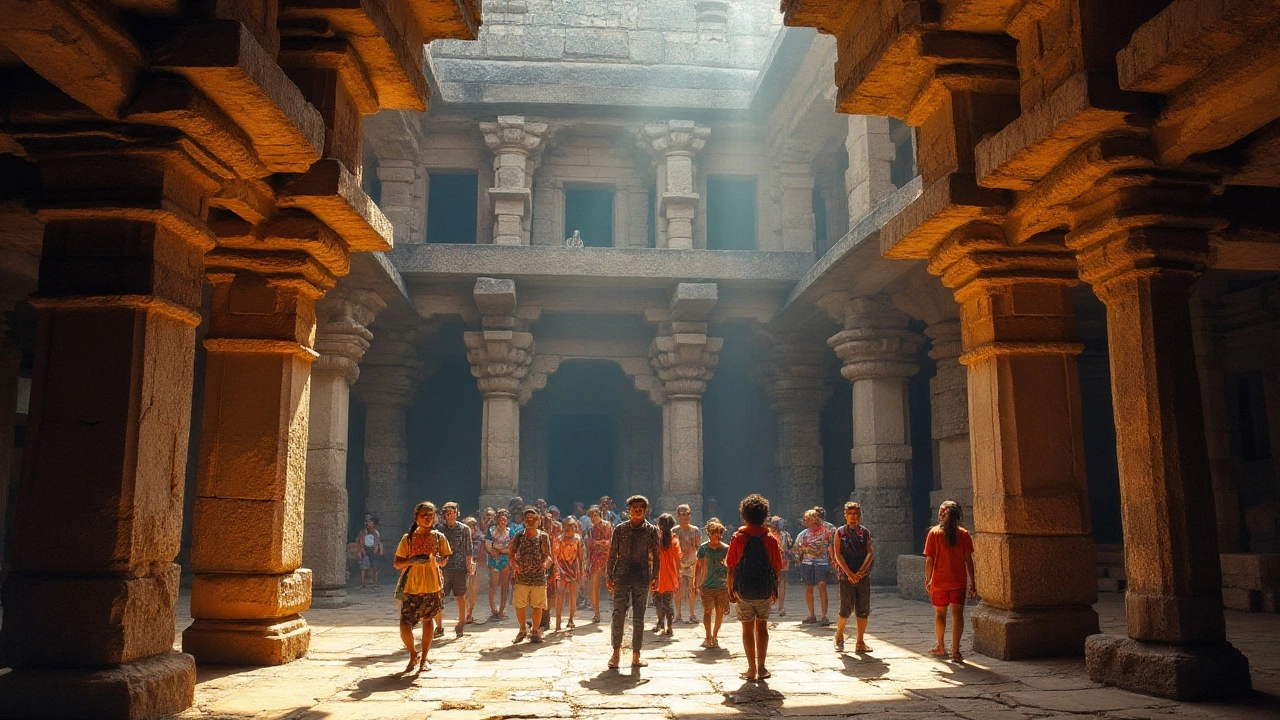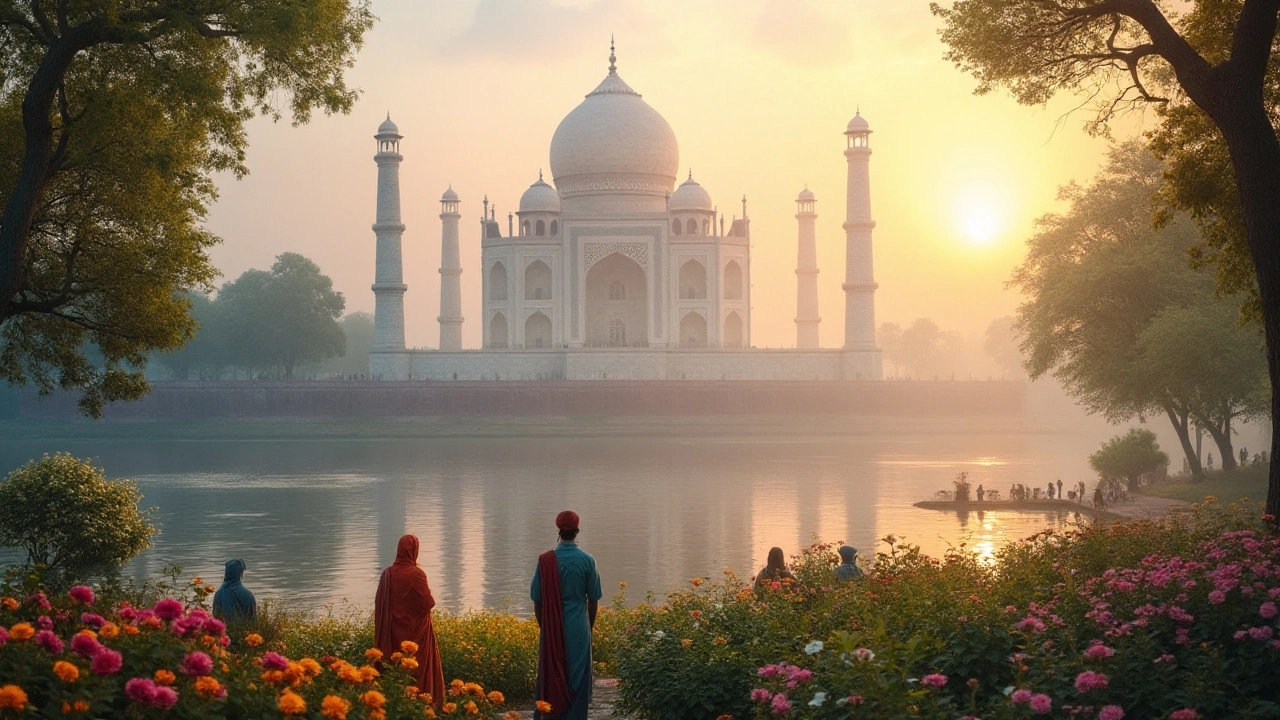India, a land woven from the threads of countless cultures and histories, boasts a tapestry rich with awe-inspiring archaeological sites. Among these, the Taj Mahal stands as a symbol of India's fascinating past and architectural brilliance. It draws millions to gaze upon its immaculate marble and hear the love story it cradles within its walls.
The journey does not end here. As you travel further, the stretches of this diverse nation reveal sites like Mohenjo-Daro—a window into civilization's infancy, whispering tales from the Harappan era. Carved into the rugged hills, the Ajanta and Ellora Caves speak through the silent stone, sharing stories etched by ancient artisans.
From the gripping narrative of the erotic sculptures at Khajuraho to the expansive forgotten empire of Hampi, India's heritage sites offer more than just visual delight. They offer an invitation to step into history, to feel the pulse of times long past, and to kindle the spark of curiosity in every wandering soul. Let's delve deeper into these treasures and unravel the layers of human ingenuity and emotion they've captured over millennia.
- The Timeless Elegance of the Taj Mahal
- Unveiling the Secrets of Mohenjo-Daro
- Ajanta and Ellora Caves: A Testament to Artistry
- The Enigmatic Temples of Khajuraho
- Hampi: A Glimpse into a Forgotten Empire
- Essentials for Exploring India's Heritage Sites
The Timeless Elegance of the Taj Mahal
The allure of the Taj Mahal is such that it transcends borders, echoing the depths of human emotion and the power of love and loss. Built in the 17th century by Emperor Shah Jahan, this magnificent mausoleum was constructed to immortalize his beloved wife Mumtaz Mahal. The passion poured into each intricate detail of its design remains a testament to the profound bond they shared, offering visitors a chance to witness another era through its grand façade and tranquil gardens.
The Taj Mahal, part of the rich tapestry of Indian architecture, gleams with exquisite craftsmanship. Its stunning symmetry is highlighted by the glistening white marble sourced from Makrana, Rajasthan. Semi-precious stones carved into vine motifs adorn the facade, creating an interplay of textures and light that shifts with the sun. This structural beauty is complemented by the lush gardens, designed in the Persian style known as charbagh, which invites serenity amidst the bustling city of Agra.
Every year, millions are drawn to this site, not just to observe its grandeur but to feel the silence enveloping its corridors—a poignant remembrance of an enduring love. As described by Rabindranath Tagore, the Taj Mahal is 'a teardrop on the cheek of time.' The monument's ethereal beauty is such that it invites contemplation; one cannot help but be swept into the stories that linger in its shadow.
"The Taj Mahal rises above the banks of the river like a solitary tear suspended on the cheek of time," wrote the Indian poet Rabindranath Tagore.
Visitors often whisper their own tales and wishes into its fissures, adding layers to the monument's living legacy. As the moonlight bathes the Taj in a silvery hue, it almost feels as though time stands still, allowing us to glimpse the past in ways that no other historic sites in India can. In its elegance and tranquility, the Taj Mahal continues to captivate the hearts and minds of those who wander through its storied paths, offering a window to a world as rich and varied as the land it graces.
Unveiling the Secrets of Mohenjo-Daro
Mohenjo-Daro, a name that stirs the sands of time, is nestled within Pakistan's Sindh province. Dating back to the 26th century BCE, it remains one of the most remarkable archaeological sites connected to the Indus Valley Civilization. Discovery of this historic site in the 1920s ignited a new chapter in South Asian archaeology, with its baked brick ruins narrating tales of a sophisticated urban planning system ahead of its time.
The ingenuity of the Mohenjo-Daro settlement is best reflected in its meticulously laid out streets, boasting a distinctive grid pattern. Houses, built from uniform bricks, included private wells and advanced drainage systems, hinting at a society that prioritized hygiene and comfort. This level of urban planning signifies a civilization that valued community welfare, demonstrating an understanding of urban living that is astonishingly modern. An intriguing aspect of this archaeological site is the Great Bath, possibly used for ritual purification, emphasizing a blend of cultural practices that underline their daily lives.
Artifacts uncovered here, ranging from delicate pottery to exquisite jewelry, provide a peek into the daily existence of its inhabitants. Scholars suggest these objects reveal a society with rich trade networks extending beyond the region, indicating advanced economic practices. The seals found at Mohenjo-Daro exhibit intricate carvings of animals and mythical figures, possibly used for trade or administrative purposes, and they continue to puzzle researchers attempting to decode the lost script of the Indus Valley.
Despite extensive research, Mohenjo-Daro still holds many unsolved mysteries. Who were these people that carved such a sophisticated niche for themselves millennia ago? Why and how did this vibrant civilization decline? As archaeologists unearth more treasures, the pieces of this historical puzzle slowly come together. The excitement of each discovery at Mohenjo-Daro adds depth to our understanding of early human civilization.
"Mohenjo-Daro is an astonishing display of human endeavor. The prowess in urban planning and architectural brilliance exhibited here predates many other civilizations," notes archaeologist John Marshall, who played a crucial role in its discovery. This observation underscores the site’s significance in the broad scope of global history.
The challenges of preserving Mohenjo-Daro are immense. Modern threats like climate change and urban encroachment risk burying its secrets forever. Conservation efforts have become paramount to sustain its legacy. As contemporary life thrums around its ancient echoes, Mohenjo-Daro remains a source of intrigue, a dialogue with the past urging us to listen, learn, and preserve.

Ajanta and Ellora Caves: A Testament to Artistry
Deep within the heart of Maharashtra lie the Ajanta and Ellora Caves, standing as monumental canvases of ancient Indian art and religious grandeur. Carved between the 2nd century BCE and 800 CE, these caves serve as remarkable examples of rock-cut architecture and artistry inspired by the religious themes of Buddhism, Hinduism, and Jainism. At Ajanta, the serene beauty is found in its thirty rock-cut cave monuments, primarily dedicated to Buddhism. These caves intricately illustrate the Jataka Tales, the stories chronicling the previous births of Gautama Buddha. Walking through these corridors, one can see how ancient artists used mineral-based paints to breathe life into stone, each stroke crafted with centuries-old precision. The colors, despite their age, echo the vividness of creativity possessed by artists of a long-gone era.
In his writings, the historian James Fergusson lauded the Ajanta Caves as the most magnificent specimens of ancient art.
"No other art can equal their radiance and elegance,"he wrote, encapsulating the emotional magnitude these visuals evoke. The Ellora Caves, located nearby, offer a contrasting yet complementary narrative. This complex of 34 caves is renowned for its architectural wonder—Kailasa Temple. This grand structure was hewn downwards through the hillside despite being made entirely out of one massive rock, representing Lord Shiva's abode and signifying one of the largest monolithic artworks in the world. Indian architecture enthusiasts marvel at the perfect symmetry and detail achieved without modern tools or techniques, a feat that still baffles today’s architects and historians alike.
Visiting these caves, you need to allocate ample time to fully absorb the spiritual ambiance and detailed artistry. Guides often point out the unique frescoes that tell stories of life's vast spectrum, from divine realms to everyday living. A journey through the Ajanta and Ellora Caves is not just a walk through history; it is an exploration into the values and expressions of ancient civilization. For those planning a visit, it might be handy to know that photography isn't allowed often to protect the sensitive pigments from light exposure. Remember that good walking shoes are essential, as the terrain can be demanding, with some caves requiring steep climbs.
Data from the Archaeological Survey of India shows that these caves attract millions of heritage seekers and travelers yearly. It is this enthusiasm that encourages preservation efforts to ensure these wonders endure, allowing future generations to witness the prowess and devotion etched in stone by their ancestors.
The Enigmatic Temples of Khajuraho
At the heart of central India, nestled in the state of Madhya Pradesh, lie the enigmatic temples of Khajuraho, revered for their intricate sculptures and architectural grandeur. These temples, constructed between 950 and 1050 AD by the mighty Chandela dynasty, have withstood the ravages of time, maintaining their magnificence in a modern world. With their detailed carvings capturing every facet of life—from the divine to the mundane, to the romantic expressions of human life—they symbolize India's vibrant culture and its appreciation of art and beauty. A fascinating aspect of these temples is their unabashed depiction of human eroticism alongside traditional deities, suggesting a society that viewed life as deeply interconnected with spirituality and the human experience.
The temples are split into three groups—western, eastern, and southern—each offering a unique yet harmonious ensemble of design. The western group, dominated by the Kandariya Mahadeva Temple, is particularly noteworthy. This impressive structure stands as a pinnacle of medieval Indian architecture, rising to 31 meters in height and adorned with over 800 sculptures, each a masterpiece in its own right. Intricately carved in sandstone, the sculptures depict a wide array of themes, from day-to-day village life to intricate depictions of heavenly beings and mythical stories. In the words of art historian Michael D. Coe, "The erotic art of Khajuraho is but a shadow of the vast religious tapestry that these walls weave."
The temples at Khajuraho are unique not only in their exquisite artwork but also for their bold portrayal of evolving Indian ideals during the medieval period. They present a unique commentary on love, life's cyclical nature, and spirituality interspersed with worldly pleasures.
The journey through Khajuraho might start at the iconic Western Group, but there's much to explore. The Eastern Group, primarily Jain temples, offer a different perspective altogether. The Parasvanath Temple, known for its non-erotic themes, displays the artistry of Jain teachings with detailed wall panels—demonstrating that the Indian architecture of these times was not monolithic but varied widely across spiritual disciplines. Indeed, wandering through Khajuraho is akin to leafing through a stone library where every carving, every pillar, and every spire tells a tale from antiquity.
Khajuraho was designated a UNESCO World Heritage Site in 1986, and rightly so, as it offers valuable insights into the sociocultural and spiritual narratives of ancient India. For travelers seeking to unravel parts of this legacy, visiting Khajuraho between October and March is recommended when the weather is pleasant, making it ideal to explore its vast complex. In recent years, the Khajuraho Dance Festival, held annually, has breathed new life into these ancient stones, showcasing Indian classical dance against the backdrop of illuminated temples. Such events underline the living heritage of Khajuraho, emphasizing not just its historical significance but also its enduring influence on contemporary cultural practices.

Hampi: A Glimpse into a Forgotten Empire
Nestled amidst the rugged landscapes of Karnataka lies Hampi, an archaeological site that echoes tales of the majestic Vijayanagara Empire. Once a thriving capital in the 14th century, today it is a UNESCO World Heritage site, enticing travelers and historians with its extraordinary blend of Indian architecture and historical significance. Hampi's vast ruins sprawled over 4,100 hectares are like scattered pages of a history book waiting to be read and cherished. At its zenith, the empire exemplified prosperity and advancement in arts and culture, making Hampi a neuralgic center of trade and governance.
Visitors to Hampi are often greeted by the mighty Virupaksha Temple, an enduring pillar of religious devotion. The temple stands tall with its intricate Dravidian architecture, attracting both the faithful and curious wanderers alike. Beyond the religious aura, the temple's gopuram steals the skyline, drawing eyes with its intricate carvings that narrate myths from ancient Hindu scriptures. Known for its chariot festival and elephant processions, the temple exudes a vibrancy that connects the present to a time when royal pageantries and cultural galas were the norm. Just a stone's throw away, the Vittala Temple complex demonstrates the historic sites of India with its impressive stone chariot, a chiseled magnificence illustrating the peak of artistic endeavors of that era.
Hampi's landscape is dotted with countless boulders, monuments, and structures that present contrasting yet complementary scenes of nature and architectural prowess. The Royal Enclosure serves as a focal point for exploring Hampi's glorious past. Within its precincts, one can find the elephant stables and the Lotus Mahal, a two-story pavilion that reflects Indo-Islamic aesthetics—a testament to the cultural exchanges and diverse influences that molded the empire. The imposing walls of the Zenana Enclosure protect a narrative of royal lives, intrigue, and the power struggles of bygone days. One enters these spaces not just as a visitor but as a time traveler basking in the opulence and beauty that were once the hallmark of a forgotten empire.
As dusk falls over Hampi, the surreal landscapes bathe in the golden hues of sunset, revealing mesmerizing rock formations that inspire awe. These natural canvases complement the architectural wonders and serve as the backdrop for the Anjanadri Hill trek, where myths of Hanuman, the monkey god, resonate through the whispers of the breeze. The Tungabhadra River meanders through Hampi, enhancing its picturesque charm and making for an idyllic end to a day spent walking through the past. Recent archaeological excavations continue to unravel secrets, continually inviting historians to piece together the enigma of Hampi’s rise and eventual fall, ensuring its saga remains as relevant today as it was centuries ago.
Essentials for Exploring India's Heritage Sites
When setting foot in India, a land famed for its heritage sites, it's akin to stepping back into history itself. As you wander through these storied spaces, it's not just the captivating architecture that leaves an indelible mark, but also the atmosphere—a palpable tapestry of narratives, whispered by the bricks and stones. To truly embrace the journey, a thoughtful approach can enrich your experience significantly. First and foremost, it's beneficial to have a flexible itinerary. While some might consider a rigid schedule efficient, in India, allowing leeway to deviate can lead to unexpected discoveries. Whether it's a sudden festival or a local guide with a tale to tell, spontaneity can be a friend.
Before embarking, investing time in understanding the climate peculiarities can greatly impact your comfort. India's climate varies starkly from the cool mist of hill stations in summer to the dry heat of the plains. Appropriate clothing, including breathable materials and layers, becomes essential. In the face of tradition, modesty is noted, particularly within sacred environments. Of interest, whispers persist that the Taj Mahal's beauty is best caught in the early morning glow or under a full moon's embrace—a claim not without merit. Expert travelers often suggest timing visits to popular sites to harmonize serenity with spectacle.
A device you'll find indispensable is a reliable guidebook or application on your smart device. These shall not only provide a gateway to history and context but also highlight lesser-known sites that often escape the tourist gaze. For those who wish for companionship on solitary walks, guided tours can bring layers of history to life through informed narratives. Drinking plenty of water is advised; hydration becomes the unsung hero in maintaining energy and focus.
Consider the local currency a humble companion in your exploration. From entry fees to souvenirs, the rupee dances at the heart of transactions. As digital payments make headway, a small stash of cash serves well, especially in quaint towns where tradition overrules technology. To up the authenticity, haggle with the same vigor for experiences as you would for crafts, for this nuanced exchange is part of India's vibrant culture. A note of importance for the gastronomic adventurer: while India offers a sumptuous spread, there's wisdom in gentle introduction for the uninitiated palate.
Finally, there's often wisdom found in heeding the locals—it's their stories that breathe life into ruins and cities alike. As you pause in a bustling market or commune with an inquisitive child outside a small museum, absorbing the world through their eyes can uncover treasures absent from maps and books alike. The ancient and the new entwine here, forging an India that's not just seen but felt. Of these sites, distinguished British archaeologist Sir Mortimer Wheeler once said:
'India is the one land that all men desire to see, and having seen once, by even a glimpse, would not give that glimpse for all the shows of all the rest of the globe combined.'Such testament grounds our exploration with a promise of enriching encounters, each as unique as the vibrant landscape itself.
